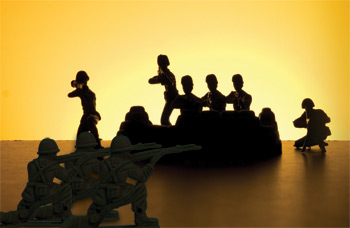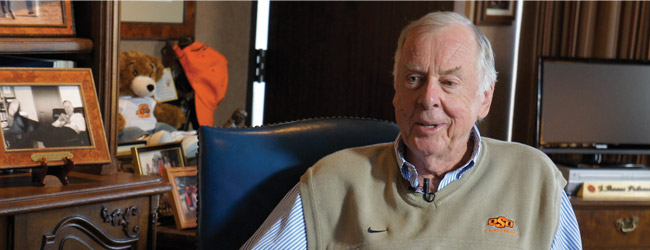
Gen. Stanley McChrystal, the U.S. commander in Afghanistan, says the United States cannot provide war-torn nations with an “endless surge” of combat forces. In an extended interview with CNN’s Christiane Amanpour, McChrystal said the United States and its allies are sending thousands of troops to help secure Afghanistan’s future by reversing the Taliban’s momentum and providing assistance to increase the Afghan national security force.
President Obama recently announced the deployment of another 30,000 U.S. forces to Afghanistan, increasing the total U.S. troop commitments to nearly 100,000—this is in addition to in excess of 100,000 troops already deployed in Iraq. Though, the president has committed to withdraw all U.S. forces in Iraq with the exception of 35,000 to 50,000 troops for training and support missions. As of February 28, 2009, some 1,454,515 people were on active duty in the military with an additional 848,000 in the seven reserve components. The Army, Navy, Marine Corps, Air Force and Coast Guard are considered armed services of the United States. All are under the direction of the Department of Defense except the Coast Guard, which was made an agency of the Department of Homeland Security in 2003 following the governmental reorganization after the 9/11 attacks. The Coast Guard may be transferred to the Department of the Navy by the president or Congress during a time of war. All five armed services are among the uniformed services of the United States; the others are the United States Public Health Services Commissioned Corps and the National Oceanic and Atmospheric Administration Commissioned Corps. Nearly 37 percent of our total armed forces reside in the reserve components. (This does not include the controversial “army for hire” defense contractors such as the well-known Blackwater.) Heavy deployments in Iraq, Afghanistan and elsewhere around the world have cut into the available pool of guard and reserve manpower. Approximately 260,000 Army Guard members and 160,000 Army Reserve personnel have been deployed under the partial mobilization declared by President Bush in September 2001, which calls up to one million reservists for no more than 24 consecutive months. The Pentagon operates under a less-demanding policy: Reservists’ service may not exceed 24 cumulative months, instead of consecutive, and individuals may not be involuntarily deployed to either Iraq or Afghanistan more than once.
The large number of U.S. armed forces in reserve components has understandably posed a challenge to both civilian employers and reserve servicemen. Service members deployed for extended periods of time while holding critical positions in civilian jobs present a challenge to employers. The patriotic service member wanting to serve his or her country is also faced with the task of being away from his or her family, maintaining a fulltime job and meeting financial obligations for up to 24 months.
Oftentimes, the service member earns significantly more in the civilian world than he or she makes in the military, creating a hardship when the mortgage or car note is due. How do we, as a society, support these selfless citizen soldiers and contribute to our country’s mission of defense? Many times, the business owner employing such an individual only understands the pain of losing a highly qualified and integral team member. The owner focuses on, looks at and feels his or her own personal loss of a valued member of the company. Sometimes it is difficult for employers to see the higher calling. The defense of our country is a sacrifice. We can allow the select few to bear the burden or we can all contribute, in some way, to the objective.
The Uniformed Services Employment and Reemployment Rights Act (USERRA) is administered by the Veterans’ Employment and Training Service (VETS). The USERRA applies to persons who perform duty, voluntarily or involuntarily, in the “uniformed services,” which include the aforementioned branches of service. Uniformed service includes active duty, active duty for training, inactive duty training, initial active duty training and funeral honors duty performed by National Guard and reserve members, as well as the period for which a person is absent from a position of employment for the purpose of an examination to determine fitness to perform any such duty.
The USERRA criteria for judging service members’ eligibility for reemployment includes the following:
- Proof of Employment – An individual must hold or have applied for a civilian job that is considered long term rather than temporary.
- Notification – Giving notice to the employer prior to active duty departure is an essential component of an individual’s eligibility for reemployment. The best proof of notice is by certified letter to the employer that declares the reason for absence and the individual’s desire to return to work, as provided by the USERRA.
- Limits of Service – An individual’s absence from work cannot exceed five years, but routine absences for National Guard and reserve training are not counted towards the total absence period.
- Character of Service – Service discharge certificates (DD- 214) must be either honorable or general. Dishonorable or bad conduct discharges disqualify the soldier for the USERRA rights. Should an individual remain in the reserve component and not be discharged, some employers may still request proof from his or her command as to the character of service.
- Prompt Return – Return to work must be prompt. For example, if the absence is not more than 30 days, a report back to the first work shift is reasonable if an individual has safely returned from his or her duty station and has had at least eight hours of rest. If an individual’s absence from work runs to 180 days, a written application to return to work within 14 days is appropriate. If an individual is absent for more than 180 days, a written application for work within 90 days after completion of service is necessary.
Job entitlement is based on the period of absence. If an individual’s period of service was less than 91 days, he or she is entitled to the job attained during the absence, provided the individual can become qualified for the new position. If the individual cannot become qualified for the new job after reasonable efforts by the employer, that person is entitled to the job he or she left.
So far, this article has discussed the challenge our nation is faced with, the burden of responsibility and the protection the law provides our brave patriots who have volunteered to shoulder the burden. But what’s in it for the business owner who chooses to support these patriotic men and women?
These service members receive work-related training and educational opportunities in the reserve components, which translates into cost savings to employers investing in service members who are fully employable and ready to work from day one. Service members/employees also receive background checks, medical screening and aptitude testing, which can help employers save on recruiting and screening costs. Additionally, the armed forces invest an incredible amount of time and money in the development of young leaders.
Leadership training is ongoing. Any service member making a career in the military will attend and complete a number of intensive courses on leadership. Regardless of a person’s status as an enlisted or commissioned officer, all progression in the armed services is, to some degree, dependent upon that person’s successful completion of acute leadership training. Leaders are trained, not born. Think about the responsibility we lay at the feet of these young men and women. It is possible that at the age of 21, a young man or woman will graduate from college with a degree and a Reserve Officers’ Training Corps (ROTC) commission in one of the armed services. A young officer may be in charge of 60 or more enlisted soldiers or a platoon of infantrymen. That 21-yearold is responsible for the lives of 60 fellow soldiers! He or she is responsible for their training, their execution of duties, oftentimes their personal lives and, more importantly, their mortal lives. Can you imagine a greater challenge for a young man or woman? Now picture a member of your team that has that kind of background. A young person who knows what it means to be a leader—one who is highly motivated and understands what it means to be a member of a team.
These men and women are in high demand. It shouldn’t be a surprise that firms like General Electric Company, American Express Company and Procter & Gamble Company aggressively recruit them. Many of these companies are recipients of the Employer Support for the Guard and Reserve (ESGR) award, which is given to companies that have shown a commitment to our armed service members.
We all bear the burden of our country’s national security, we all have a roll to play and we can all contribute. It’s too easy to pass the buck and separate ourselves from the enormous sacrifice so many of our young people are shouldering. These men and women are the best our country has to offer—they are our future leaders. An overwhelming majority of our country’s presidents have all served in uniform in some capacity. It has been my great pleasure to serve our country, and I know many of my team members can proudly say the same.
Go Army! Hoo-rah!




